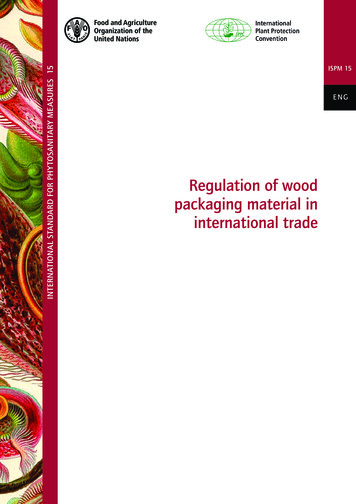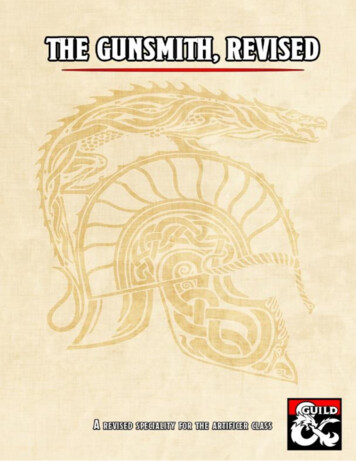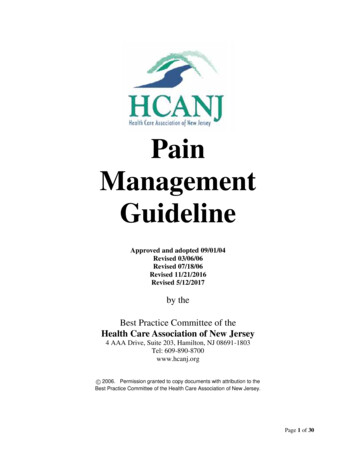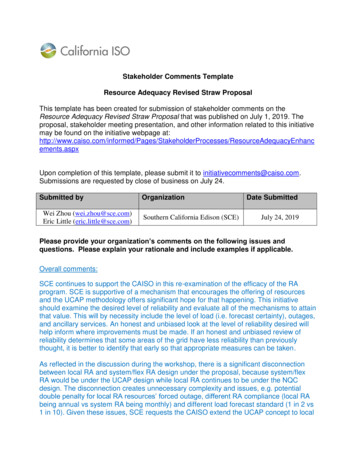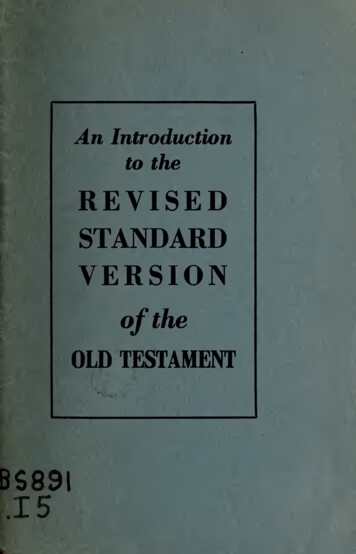
Transcription
farm .4 n Introductionto ther '. i V-'- ? "''*v. RV:A)\: tL:\IfcV-V ’\v '*rI- - jREVISEDSTANDARDVERSION'If.of theOLD TESTAMENTBS89I.15
An Introductionto theREVISED STANDARD VERSIONof theOLD TESTAMENT
An Introductionto theREVISED STANDARD VERSIONof theOLD TESTAMENTMEMBERS OF THEREVISION COMMITTEELUTHER A. WEIGLEIChairmanTORONTOTHOMAS NELSON 8c SONSNEW YORKEDINBURGH
Copyright 1952by Division of Christian Education of theNational Council of the Churches of Christin the United States of AmericaThis book has been copyrighted to protect its text; but it is the hope of therevisers that the information it contains may receive wide circulation, and tothis end the editors of all responsible journals are invited to use this bookas a resource from which material may be reproduced without charge. Manychurch papers and secular journals will wish to publish some or all of thesechapters in their columns, and they are invited to do so. Permission may besecured from the Division of Christian Education of the National Council ofthe Churches of Christ in the United States of America, which holds the copy right of this book and the copyright of the Revised Standard Version of theNew Testament.Printed in the U. S. A.
CONTENTSChapterPageI. Preface to the Revised Standard Version of the OldTestament.5—%II. Method and Procedure of the Revision.11William A. IrwinIII. The Authorized Revisions of the King James Version .20George DahlIV. The Hebrew Text and the Ancient Versions of the OldTestament.24Harry M. OrlinskyV.The Language of the Old Testament.S2William F. AlbrightVI. The Geography of the Old Testament and the RevisedStandard Version.41Herbert G. MayVII. Archaeology and the Translation of the Old Testament49J. Philip HyattVIII. The Style and Vocabulary of the Revised StandardVersion of the Old Testament.56Millar BurrowsIX. The Poetry of the Old Testament.62James MuilenburgX. The Wisdom Literature of the Old Testament.70Leroy WatermanXI. Preaching Values of the Revised Standard Version—theProphets.75Willard L. SperryXII. The Use of the Old Testament in Worship.78Fleming JamesXIII.Some Misleading Words in the King James Version.83XIV.The Revision Committee and the Advisory Board.88
The chapters of this book have been written by members of theCommittee which has worked upon the Revised Standard Versionof the Old Testament, published in September 1952. They areaddressed to the general public, and are designed to help the readerof the Bible to understand the main principles which have guidedthis comprehensive revision of the King James and AmericanStandard Version.There are no chapters by five members of the Old TestamentSection. Professor Moffatt, Executive Secretary, died in 1944; andProfessor Taylor, who made the first draft of the revision of thePsalms in 1951. Professor Bewer, an active member of the Committeefrom 1930 till the completion of its work, was prevented by illnessfrom assuming responsibility for a chapter. Dr. Yates, after eightyears of active service, accepted the pastorate of the Second BaptistChurch, Houston, Texas, and has since then shared in the Com mittee’s work only by correspondence and the criticism of proofs.Dean Weigle has edited this book.
I. PREFACE TO THE REVISED STANDARD VERSIONOF THE OLD TESTAMENTTRevised Standard Version of the Bible is an authorizedrevision of the American Standard Version, published in 1901,which was a revision of the King James Version, published in 1611.The first English version of the Scriptures made by direct trans lation from the original Hebrew and Greek, and the first to beprinted, was the work of William Tyndale. He met bitter opposition.He was accused of wilfully perverting the meaning of the Scriptures,and his New Testaments were ordered to be burned as “untruetranslations.” He was finally betrayed into the hands of his enemies,and in October, 1536, was publicly executed and burned at the stake.Yet Tyndale’s work became the foundation of subsequent Englishversions, notably those of Coverdale, 1535; Thomas Matthew (prob ably a pseudonym for John Rogers), 1537; the Great Bible, 1539;the Geneva Bible, 1560; and the Bishops’ Bible, 1568. In 1582 atranslation of the New Testament, made from the Latin Vulgate byRoman Catholic scholars, was published at Rheims.heThe translators who made the King James Version took intoaccount all of these preceding versions; and comparison shows that itowes something to each of them. It kept felicitous phrases and aptexpressions, from whatever source, which had stood the test of publicusage. It owed most, especially in the New Testament, to Tyndale.The King James Version had to compete with the Geneva Biblein popular use; but in the end it prevailed, and for more than twoand a half centuries no other authorized translation of the Bibleinto English was made. The King James Version became the“Authorized Version” of the English-speaking peoples.The King James Version has with good reason been termed “thenoblest monument of English prose.” Its revisers in 1881 expressedadmiration for “its simplicity, its dignity, its power, its happy turnsof expression . . . the music of its cadences, and the felicities of its5
6Preface to the Revised Standard Versionrhythm.” It entered, as no other book has, into the making of thepersonal character and the public institutions of the English-speak ing peoples. We owe to it an incalculable debt.Yet the King James Version has grave defects. By the middleof the nineteenth century, the development of Biblical studies andthe discovery of many manuscripts more ancient than those uponwhich the King James Version was based, made it manifest that thesedefects are so many and so serious as to call for revision of the Englishtranslation. The task was undertaken, by authority of the Church ofEngland, in 1870. The English Revised Version of the Bible waspublished in 1881-1885; and the American Standard Version, itsvariant embodying the preferences of the American scholars asso ciated in the work, was published in 1901.Because of unhappy experience with unauthorized publicationsin the two decades between 1881 and 1901, which tampered with thetext of the English Revised Version in the supposed interest of theAmerican public, the American Standard Version was copyrighted,to protect the text from unauthorized changes. In 1928 this copyrightwas acquired by the International Council of Religious Education,and thus passed into the ownership of the churches of the UnitedStates and Canada which were associated in this Council throughtheir boards of education and publication.The Council appointed a committee of scholars to have chargeof the text of the American Standard Version and to undertakeinquiry as to whether further revision was necessary. For more thantwo years the Committee worked upon the problem of whether ornot revision should be undertaken; and if so, what should be itsnature and extent. In the end the decision was reached that thereis need for a thorough revision of the version of 1901, which willstay as close to the Tyndale-King James tradition as it can in thelight of our present knowledge of the Hebrew and Greek texts andtheir meaning on the one hand, and our present understanding ofEnglish on the other.In 1937 the revision was authorized by vote of the Council,which directed that the resulting version should “embody the bestresults of modern scholarship as to the meaning of the Scriptures,and express this meaning in English diction which is designed foruse in public and private worship and preserves those qualities which
Preface to the Revised Standard Version7have given to the King James Version a supreme place in Englishliterature.”Thirty-two scholars have served as members of the Committeecharged with making the revision, and they have secured the reviewand counsel of an Advisory Board of fifty representatives of theco-operating denominations. The Committee has worked in twosections, one dealing with the Old Testament and one with theNew Testament. Each section has submitted its work to thescrutiny of the members of the other section, however; and thecharter of the Committee requires that all changes be agreed uponby a two-thirds vote of the total membership of the Committee.The Revised Standard Version of the New Testament was pub lished in 1946. The publication of the Revised Standard Versionof the Bible, containing the Old and New Testaments, was author ized by vote of the National Council of the Churches of Christin the U.S.A. in 1951.The problem of establishing the correct Hebrew and Aramaictext of the Old Testament is very different from the correspondingproblem in the New Testament. For the New Testament we havea large number of Greek manuscripts, preserving many variantforms of the text. Some of them were made only two or three cen turies later than the original composition of the books. For theOld Testament only late manuscripts survive, all (with the excep tion of the Dead Sea texts of Isaiah and Habakkuk and somefragments of other books) based on a standardized form of the textestablished many centuries after the books were written.The present revision is based on the consonantal Hebrew andAramaic text as fixed early in the Christian era and revised byJewish scholars (the “Masoretes”) of the sixth to ninth centuries.The vowel-signs, which were added by the Masoretes, are acceptedalso in the main, but where a more probable and convincing read ing can be obtained by assuming different vowels, this has beendone. No notes are given in such cases, because the vowel pointsare less ancient and reliable than the consonants.Departures from the consonantal text of the best manuscriptshave been made only where it seems clear that errors in copyinghad been made before the text was standardized. Most of the cor-
8Preface to the Revised Standard Versionrections adopted are based on the ancient versions (translationsinto Greek, Aramaic, Syriac, and Latin), which were made beforethe time of the Masoretic revision and therefore reflect earlierforms of the text. In every such instance a footnote specifies theversion or versions from which the correction has been derived, andalso gives a translation of the Masoretic Text.Sometimes it is evident that the text has suffered in transmission,but none of the versions provides a satisfactory restoration. Herewe can only follow the best judgment of competent scholars as tothe most probable reconstruction of the original text. Such correc tions are indicated in the footnotes by the abbreviation Cn, and atranslation of the Masoretic Text is added.The discovery of the meaning of the text, once the best readingshave been established, is aided by many new resources for under standing the original languages. Much progress has been made in thehistorical and comparative study of these languages. A vast quantityof writings in related Semitic languages, some of them only recentlydiscovered, has greatly enlarged our knowledge of the vocabularyand grammar of Biblical Hebrew and Aramaic. Sometimes thepresent translation will be found to render a Hebrew word in asense quite different from that of the traditional interpretation. Ithas not been felt necessary in such cases to attach a footnote,because no change in the text is involved and it may be assumedthat the new rendering was not adopted without convincing evi dence. The analysis of religious texts from the ancient Near Easthas made clearer the significance of ideas and practices recordedin the Old Testament. Many difficulties and obscurities, of course,remain. Where the choice between two meanings is particularlydifficult or doubtful, we have given an alternative rendering in afootnote. If in the judgment of the Committee the meaning of apassage is quite uncertain or obscure, either because of corruptionin the text or because of the inadequacy of our present knowledge ofthe language, that fact is indicated by a note. It should not beassumed, however, that the Committee was entirely sure or unani mous concerning every rendering not so indicated. To record allminority views was obviously out of the question.A major departure from the practice of the American StandardVersion is the rendering of the Divine Name, the “Tetragramma-
Preface to the Revised Standard Version9ton/' The American Standard Version used the term “Jehovah”;the King James Version had employed this in four places, buteverywhere else, except in three cases where it was employed as partof a proper name, used the English word Lord (or in certain casesGod) printed in capitals. The present revision returns to the pro cedure of the King James Version, which follows the precedent ofthe ancient Greek and Latin translators and the long establishedpractice in the reading of the Hebrew scriptures in the synagogue.While it is almost if not quite certain that the Name was originallypronounced “Yahweh,” this pronunciation was not indicated whenthe Masoretes added vowel signs to the consonantal Hebrew text.To the four consonants YHWH of the Name, which had come tobe regarded as too sacred to be pronounced, they attached vowelsigns indicating that in its place should be read the Hebrew wordAdonai meaning “Lord” (or Elohim meaning “God”). The ancientGreek translators substituted the word Kyrios (Lord) for the Name.The Vulgate likewise used the Latin word Dominus. The form“Jehovah” is of late medieval origin; it is a combination of theconsonants of the Divine Name and the vowels attached to it bythe Masoretes but belonging to an entirely different word. Thesound of Y is represented by J and the sound of W by V, as inLatin. For two reasons the Committee has returned to the morefamiliar usage of the King James Version: (1) the word “Jehovah”does not accurately represent any form of the Name ever used inHebrew; and (2) the use of any proper name for the one and onlyGod as though there were other gods from whom he had to be dis tinguished was discontinued even in Judaism before the Christianera and is entirely inappropriate for the universal faith of theChristian Church.A major reason for revision of the King James Version, whichis valid for both the Old Testament and the New Testament, isthe change since 1611 in English usage. Many forms of expressionhave become archaic, while still generally intelligible—the use ofthou, thee, thy, thine and the verb endings -est and -edst, the verbendings -eth and -th, it came to pass that, whosoever, whatsoever,insomuch that, because that, for that, unto, howbeit, peradventure, holden, aforetime, must needs, would fain, behooved, to you ward, etc. Other words are obsolete and no longer understood by
10Preface to the Revised Standard Versionthe common reader. The greatest problem, however, is presented bythe English words which are still in constant use but now conveya different meaning from that which they had in 1611 and in theKing James Version. These words were once accurate translationsof the Hebrew and Greek Scriptures; but now, having changed inmeaning, they have become misleading. They no longer say whatthe King James translators meant them to say.The King James Version uses the word “let" in the sense of“hinder,” “prevent” to mean “precede,” “allow” in the sense of“approve,” “communicate” for “share,” conversation” for “conduct,”“comprehend” for “overcome,” “ghost” for “spirit,” “wealth” for“well-being,” “allege” for “prove,” “demand” for “ask,” “take nothought” for “be not anxious,” “purchase a good degree” for “gaina good standing,” etc. The Greek word for “immediately” is trans lated in the King James Version not only by “immediately” and“straightway” but also by the terms “anon,” “by and by” and“presently.” There are more than three hundred such English wordswhich are used in the King James Version in a sense substantiallydifferent from that which they now convey. It not only does theKing James translators no honor, but is quite unfair to them andto the truth which they understood and expressed, to retain thesewords which now convey meanings they did not intend.All the reasons which led to the demand for revision of theKing James Version in the nineteenth century are still valid, andare even more cogent now than then. We have had a freer charterthan our predecessors in the 1870’s in that we have not beenrequired, as they were, to limit the language of the English Bibleto the vocabulary of the Elizabethan age. But we hope that wehave not taken undue advantage of that freedom. The RevisedStandard Version is not a new translation in the language of today.It is not a paraphrase which aims at striking idioms. It is arevision which seeks to preserve all that is best in the English Bibleas it has been known and used through the years. It is intendedfor use in public and private worship, not merely for reading andinstruction. We have resisted the temptation to use phrases thatare merely current usage, and have sought to put the message of theBible in simple, enduring words that are worthy to stand in thegreat Tyndale-King James tradition. We are glad to say, with the
Method and Procedure of the Revision11King James translators: “Truly (good Christian Reader) we neverthought from the beginning, that we should need to make a newTranslation, nor yet to make of a bad one a good one . . . but tomake a good one better.”The Bible is more than a historical document to be preserved.And it is more than a classic of English literature to be cherishedand admired. It is a record of God’s dealing with men, of God’srevelation of Himself and His will. It records the life and work ofHim in whom the Word of God became flesh and dwelt amongmen. The Bible carries its full message, not to those who regard itsimply as a heritage of the past or praise its literary style, but tothose who read it that they may discern and understand God’s Wordto men. That Word must not be disguised in phrases that are nolonger clear, or hidden under words that have changed or lost theirmeaning. It must stand forth in language that is direct and plainand meaningful to people today. It is our hope and our earnestprayer that this Revised Standard Version of the Bible may beused by God to speak to men in these momentous times, and tohelp them to understand and believe and obey His Word.II. METHOD AND PROCEDURE OF THE REVISIONTBible is the great book of the western world, increasinglyof the entire world. The intensive Biblical studies of the pasthundred years along with the phenomenal bulk of knowledge ofancient times which has come into our possession through studyof the lands of the Near East have combined to make clearer itsunrivaled place. What was formerly a matter of faith has become inour times an established result of historical research. The Bible isunique. Among the older, and physically greater, cultures of theancient world, there was nothing which remotely approached itsexalted outlook upon the world and the nature and duty of man.And down succeeding centuries it has more and more exerted aformative influence upon society. Carried by Jews and by Christiansthrough the length and breadth of the Roman world, it became apervasive force which in the fourth century arrived at one of thehe
12Method and Procedure of the Revisiondeeper crises of Christian history when the Biblical interpretationof life became official in the empire. Hardy missionaries went withit to the savage tribes that lived beyond the Alps and the Car pathians, and by its teachings civilized our remote ancestors.Increasingly it became the guide and authority of the life of westernEurope; then with the Protestant Reformation it came to new cen trality and power, and through the great historical expansion ofthe succeeding centuries it was carried through all the westernworld. Of minor purport is it to comment that the Bible stands,to the present, well beyond its nearest rival among best sellingbooks; the real point is that it has permeated the outlook andmotivation, the basic philosophy of life, of the modern world.Since the third century B.C., the demand for the Scriptures in afamiliar tongue has found expression in a great activity of Bibletranslation that goes on unabated. In this long tradition the historyof our English Bible holds an honored place. It had its beginningin the folk paraphrases of devout spirits in Anglo-Saxon times; itcame to notable attainment in the great work that goes under thename of John Wycliffe; but the modern English Bible begins in thetime of the Reformation, with the work of Tyndale and of Coverdale. It is well known that their very wording, sometimes in con siderable bulk, has come through all the intervening work, to standin latest translations as the best and most graceful rendering ofthe Biblical thought. The notable succession of translations downto and including the King James Version in 1611 were all basedupon the work of these two. The statement on the title page ofthe King James Version is of a significance seldom realized, “Trans lated out of the original tongues, and with the former translationsdiligently compared and revised.” Those who have pondered thesewords, still more those who as well have studied the remarkablepreface, to the King James entitled, “The Translators to theReader,” will be in a position to understand the toil and care,and the thoughtful acceptance of all previous labor which goesinto any worthy work of Bible translation.The present work likewise is primarily a revision. Its officialtitle declares this: it is the Revised Standard Version, that is, arevision of the American Standard Version of 1901, which had itsultimate inception in the official action of the Church of England
Method and Procedure of the Revision13in 1870 that authorized a revision of the King James Version.Through its entire activity the committee for the Revised StandardVersion has been conscious of its role as reviser. The AmericanStandard Version was its basic English text, and from it deviationswere permitted only by majority vote, subject to final ratificationby a two-thirds vote.A task of revision entails all the problems and difficulties oftranslation, and in addition, one that is peculiarly its own: whatdegree of change from the basic text is permissible? It is a ques tion of peculiar urgency when the revision concerns the Bible, forits very words quickly endear themselves to the devout student, sothat any alteration, however slight, can well appear almost adesecration.But further, any process of translation is in a sense an effort atthe impossible. Languages differ; they are projections of the person alities of those for whom the speech learned in childhood is asintimate and personal as their native air. From these, the transla tors are separated by insuperable psychological barriers. The bestthat can be hoped is an approximation to the thought of theoriginal, but its finer points, its overtones, its allusions, the feelingand atmosphere of its words lie beyond any process of translation.This is especially true when the task is that of rendering classicsof an ancient language, such as the Old Testament includes, intoa modern tongue of far remote genius and relationships. All speechdevelops its peculiar expressions that vary from mere slang across adiverse terrain to proverbial sayings at the other end. Colloquial isms soon pass, either into standard speech, or into desuetude asderelicts of a once pulsing reality; then life moves on and forgetstheir occasion and significance. One who works long and seriouslywith the Hebrew Old Testament grows steadily more consciousthat much of its allusive and delicate meaning has been for everlost; the words are known—generally—but their significance inparticular combinations allures, but evades, the student.However this may be, the responsibility of the translator isclear. Representing the best extant understanding of the languagewith which he deals, he is charged to tell as accurately as he canin his own language precisely what the original says. This is of animportance to bear some emphasis. The Bible translator assumes a
14Method and Procedure of the Revisionstrict responsibility to say in English just what the Biblical writerssaid in Hebrew, or in Aramaic, or in Greek, as the case may havebeen. In response to early publicity about the launching of theRevised Standard project, letters came in to one or another ofthe committee pointing out their opportunity to deal a blow tocertain anti-social views which unfortunately base themselves onthis or that Bible passage—the committee should change the offend ing passage! The only answer that could be given was that thecommittee did not intend, nor had it any authority, to change theBible. The purpose was to give a more accurate rendering of whatit said, even in these passages. Correction of wrong uses of theBible, important as this may be, lay entirely outside its responsi bility.Yet this is not all. The danger here is of a subtle sort. A recentspeaker has told of a project to issue “a theologically conservativetranslation of the Bible.” Doubtless this is an appealing undertak ing in the eyes of many. But the fact must be stressed that thereis no place for theology in Bible translation, whether conservativeor radical or whatever else. A “theological translation” is not atranslation at all, but merely a dogmatic perversion of the Bible.Linguistic science knows no theology; those of most contradictoryviews can meet on common ground devoid of polemic, agreedthat Hebrew words mean such and such, and their inflection andsyntactical relations imply this or that. These facts establish anagreed translation. Then, and then only, may the exegete anddogmatist busy himself with theological deductions from thethoughts of the Biblical writers. The Bible translator is not anexpositor; however pronounced his views about Biblical doctrines,he has no right whatever to intrude his opinions into the transla tion, or to permit his dogmatic convictions to qualify or shapeits wording. His one responsibility, and it is absolute, is to renderthe Biblical meaning as accurately and effectively as is possible intoappropriate English.Likewise the translator must be on guard against paraphrase.He must steer between Scylla and Charybdis, and the channel isnarrow! Avoiding paraphrastic rendering, it is easy for him to fallinto a rigid, mechanical procedure that deprives the result of bothlife and beauty. No one is a translator who believes that each foreign
Method and Procedure of the Revision15word has its English equivalent, and that the process of translationis something like shifting pieces in a jigsaw puzzle. A more sinisterform of the temptation is to hold that faithfulness binds one tosimilar sentence structure and, in particular, verbal inflection, andso on. Or again the tempter may come in the cloak of consistency:surely it is necessary that translation reveal the presence of certaingreat words in the original, or the substitution of some approximatesynonym; and can this be done other than by adopting the bestavailable English equivalent for the word or phrase and then usingit at every occurrence? While there is much that is sound in thisargument, the result can easily run off into a wooden style, thatlacks all the beauty and force of the original. Yet to abandon therestraints imposed by these considerations comes close to throwingopen the doors to paraphrase. There is a difference, however, whichthe skilful translator will recognize; indeed his merit not uncom monly is to be gauged by his decisions at these points. He mustpossess an elasticity of mind and of method that will hold trueto the demands of the original and yet will discover a way ofrendering it in graceful and forceful English. It is not adequateto define translation as the process of rendering the thought of theoriginal into another language; it is all that, and much more. Itshould give some feeling of the literary quality of the originalwriter: his command and use of his language, his mood, his figuresof speech, his structure of thought. Yet not least, all must cohere inidiomatic English that possesses grace and beauty and power.The greatness of the King James Version of the Bible—andbeyond all cavil it is one of the great Bible translations—lies, asevery reader recognizes, in its superb literary qualities. Commonlyit has been pointed out that the King James Version was createdin the great age, the classic age, one might say, of the language.But what is almost as commonly overlooked is that it owes its merit,not at all to seventeenth century English—which was far different—but to its faithful rendering of the original. The style of the EnglishBible is the style of the Hebrew, and of the Koin Greek of NewTestament times. Rather than a child of seventeenth centuryEnglish, it is parent of the English of today. Its lucid clarity hasestablished itself as the standard of good writing; its great phraseshave passed over into common usage; many of its figures of speech
16Method and Procedure of the Revisionhave established themselves in the language as indigenous English!The story of the inception of the revision, of its early activity,which when only well begun was interrupted by the great depres sion of the 1930’s, has been told by Dean Weigle in the Introductionto the Revised Standard Version of the New Testament. In 1937the International Council of Religious Education authorized therevision, and reconstituted the committee to undertake it. Thefirst meeting of the reconstituted committee began at 9 a.m.,December 3, 1937, in the Directors’ Room of the Union Theo logical Seminary, New York. It was to prove the only meeting ofthe full committee; otherwise its work was carried forward in theseparate sections for the Old and New Testaments. The concern ofthis first meeting was the establishment of principles and thesetting of modes and procedures for the work.At this first meeting the six memb
The Revised Standard Version of the New Testament was pub lished in 1946. The publication of the Revised Standard Version of the Bible, containing the Old and New Testaments, was author ized by vote of the National Council of the Churches of Christ in the U.S.A. in 1951.







